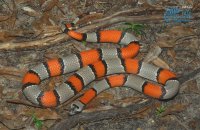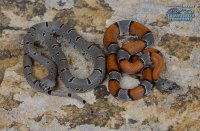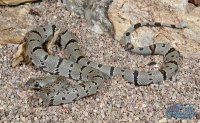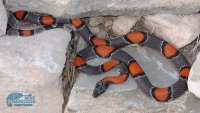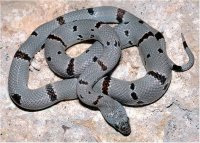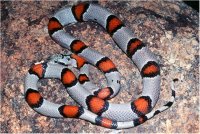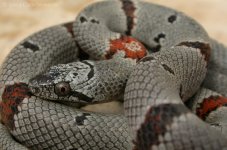| Range: |
 The gray-banded kingsnake ranges from southeastern New Mexico. There are only two verified specimen records from New Mexico; both are in southwestern Eddy County. It is likely that the species is limited to southwestern Eddy and southeastern Otero counties in New Mexico. The gray-banded kingsnake ranges from southeastern New Mexico. There are only two verified specimen records from New Mexico; both are in southwestern Eddy County. It is likely that the species is limited to southwestern Eddy and southeastern Otero counties in New Mexico. |
| Other Names: |
Grayband, Alterna King, Blair's Kingsnake |
| Description: |
Two distinct subspecies of Lampropeltis alterna, as L. a. alterna and L. a. blairi differentiated by patterning and locale, but research has shown them to be morphs of the same species. Gray-banded kingsnake can grow up to 4 ft (120 cm) in total length (including tail), with the average total length being 3 ft. L. alterna coloration and patterning vary greatly, but there are two main color morphs, which were once considered separate subspecies: the "blairi" which has wide red/orange banding, and the "alterna" which has thinner orange/red banding. Both are generally on a gray background with white and/or black accenting. There are many variations on this basic morphology found in the wild and captive bred, with some specimens even lacking orange or red banding entirely. |
| Similar Species: |
Rock Rattlesnake has rattle and keeled scales. Lyre snakes have vertical pupils. |
| Venom: |
None |
| Habitat: |
Gray-banded kingsnakes inhabit broken, rocky areas where they can access deep fissures and crevices for shelter and in pursuit of food. They are rarely found above ground during daylight hours. The secretive habits of this snake and ruggedness of terrain where it occurs make quantitative assessments of status impossible. However, it is believed that the species is not locally abundant
anywhere in New Mexico, and that its distribution may also be highly fragmented due to specific habitat needs, in which case individual populations may be small and unevenly distributed. |
| Behavior: |
Very secretive & nocturnal. Raptors, coyotes and other king snakes are natural predators. Humans collect them for the pet trade. While legal to take in Texas, they are illegal to collect or possess in New Mexico punishable by confiscation and fines. |
| Hibernation: |
October through March |
| Reproduction: |
L. alterna is oviparous, laying clutches of 3-13 eggs in early summer, which hatch in approximately 9 weeks. Each hatchling is around 10 inches. |
| Diet: |
Mostly lizards, some small rodents. |
Authored by: Jerry Tuttle

